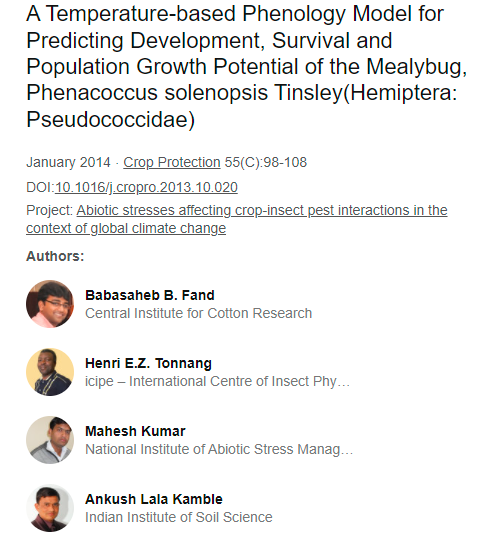The temperature-dependent population growth potential of Phenacoccus solenopsis Tinsley, a highly polyphagous and invasive mealybug species, was studied on sprouted potatoes under laboratory conditions at six constant temperatures (15-40 oC). Several non-linear equations were fitted to the obtained data to model temperature-dependent population growth and species life history. The established equations for each life age/stage of the species were compiled to obtain an overall temperature-dependent phenology model. The life table parameters of P. solenopsis were estimated using stochastic simulation centred on a rate summation and cohort up-dating approach. The theoretical lower development threshold temperatures estimated using linear regressions applied to mean development rates were 11.2, 8.9, 9.8 and 12.7 oC, and the thermal constants for development were 93.7, 129.8, 97.1 and 100.0 degree days (DD) for nymph 1, nymph 2, nymph 3 and male pupa stages, respectively. The developed phenology model predicted temperatures between 25-35 oC as the favourable range for P. solenopsis development, survival and reproduction. P. solenopsis population attained a maximum net reproductive rate (107-108 females/female/generation) and total fecundity (216.6 – 226.5 individuals/female/generation) at temperatures between 25-30 oC. Mean length of generations decreased from 75.6 days at 15 oC to 21 days at 40 oC. The maximum finite rate of increase (1.12 – 1.16 females/female/day) and shortest doubling time (4.3 – 6.1 days) were also observed at temperatures between 25-35 oC. The simulation of phenology model at fluctuating temperatures indicated that P. solenopsis populations might potentially increase with a finite rate of 1.06 females/female/day with an average generation time of 58.7 days and a doubling time of 12.1 days. The obtained life table parameters were reasonably similar when compared with literature data. The present model can be simulated spatially for estimating the pest risk and undertaking agro-ecoregion specific pest management strategies.

